Houbigant
Continued onto: Houbigant (post-1930)
Tradition has it that Houbigant was founded in 1775 by Jean-François Houbigant at 19 Rue du Faubourg Saint-Honoré under the sign ‘A la corbielle de fleurs’ in what was then a developing region of Paris.
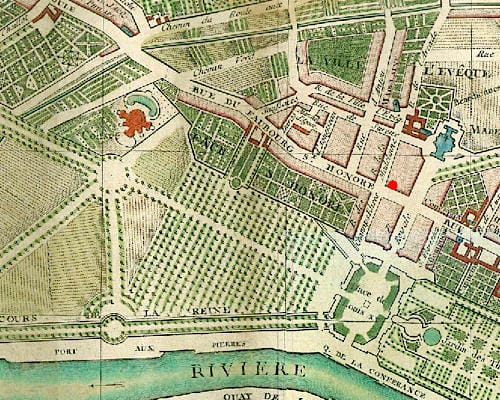
Above: 1780 Map of Paris with Maison Houbigant marked with a red dot. The oval shaped Place de la Louis XV at the bottom of the map, now known as the Place de la Concorde, was the site of public guillotines during the French Revolution.
Tradition also says that Houbigant remained at this address for the next two centuries but this was not the case during the revolutionary period. Houbigant was listed at no. 36 Rue du Faubourg Saint-Honoré in 1799 and 1800 but at No. 55 in 1801 and an undated price list from the period has an additional address at No. 57. The reason for the moves is unknown to me but given the turmoil of the period they are very understandable.
Products
Houbigant put marchand parfumeur (perfume merchant) on the top of his bills and product lists but he did not manufacture parfums in the way we think about them today. with their closest equivalents being extraits (extracts). It is also worth noting that although the twentieth-century owners of Houbigant wanted to emphasise the firm’s long history in the field that, until the 1880s, Houbigant was equally well known as a glove maker.

Above: An early engraving of Houbigant’s shop at 19 Rue du Faubourg Saint-Honoré. If I am translating the signage abbreviation correctly it reads: Supplier of Perfumes – Houbigant – Glove Store.
In addition to a selection of scented and unscented gloves, a Houbigant product list from the early nineteenth century lists a wide variety of items including; scented powders, scented pomades for the hair, floral extracts, toilet waters, toilet vinegars, and soaps. Customers could also buy scented handkerchiefs and fans, as well as sachets, flower baskets, potpourris, and burning pastilles to add fragrance to a room.
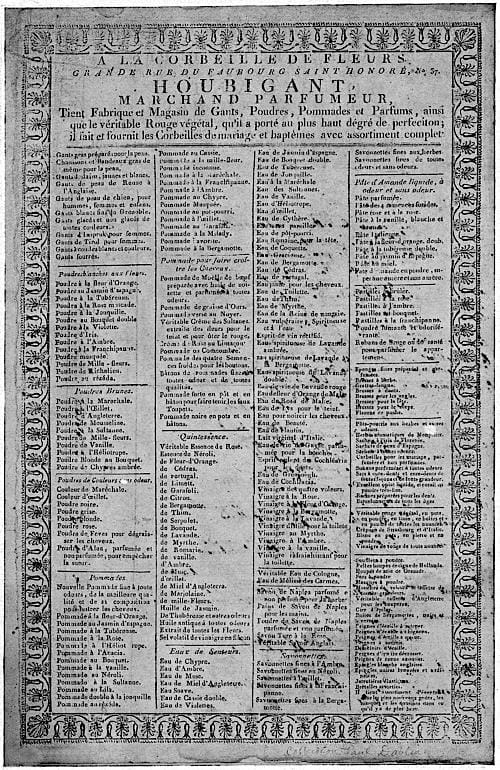
Above: Greyscale print of a Houbigant product list from the early nineteenth century (La parfumerie française et l’art dans la présentation, 1925).
Other listed products include an epilating wax (cire à épiler), beauty spots (barcelonnettes et mouches), combs, garters, suspenders; an assortment of brushes for the body, hair and teeth; a hair degreaser (poudre de feves); an astringent used to reduce sweating (poudre d’alun); and an opium preparation (opiat liquide) presumably for toothache.
The powders Houbigant sold would have been used on wigs as well as the face and body and were desired as much for their ability to mask odours as for their colouring. Some of the powders were tinted, e.g. couleur de maréchale (blue), and couleur d’oeillet (carnation), while others came in black, grey, blonde, and rose shades. It is difficult to know how these were used but theatrical make-up is one possibility.
Houbigant’s rouges also came in a range of shades. The rouge végétal, made with vegetable red could be purchased in a variety of forms including pots, saucers and boxes, but he also sold carmine impregnated ribbons (crépons) and a liquid rouge (vinaigre de rouge).
See also: Rouge
Later owners
Houbigant’s son, Armand Gustave Houbigant [1790-1863], did not follow his father into the business, electing instead to travel and follow more artistic and literary pursuits. This resulted in Houbigant becoming Houbigant-Magny after his mother, Nicole Adéläide Houbigant (née Deschamps) married François Magny in 1808. Records of later ownership changes are far from complete but the business appears to have passed to Félix Chardin in 1815 after which it became known as Houbigant-Chardin.
Houbigant-Chardin
Houbigant-Chardin went through a number of owners during the nineteenth century. A note attached to the Houbigant papers in the French National Archives suggests that Charles Gabillot bought Houbigant-Chardin in 1829 but I have no confirmation of this claim. Later owners that I have records for were: 1. Gabillot et Compagnie (1854), a partnership formed by Charles Gabillot, Charles Adolphe Napoleon, and Madeline-Anne Grand; 2. Gilbert et Dormage (1861), owned by Paul Gilbert Gabillot (Charles Gabillot’s son) and Eugène Domage; 3. Henri Parquet (1878); and 4. Javal et Parquet (1881) a partnership formed by Paul-Marie Parquet [1865-1916] (Henri Parquet’s son) and Alfred Ernest Javal [1844-1912].
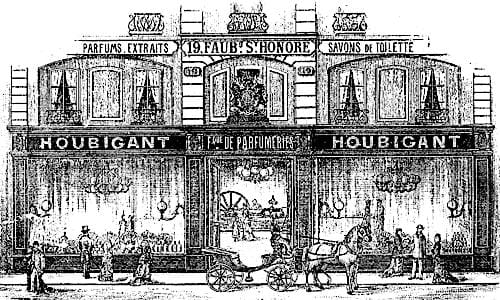
Above: Houbigant-Chardin shop at 19 Rue du Faubourg Saint-Honoré. The numerous windows in the original shop have been replaced with two single, plate-glass windows, there is new signage, and what appears to be a steam-driven machine at the back of the shop. The engraving must have been done after 1838 as the British royal coat of arms is displayed above the front door.
Houbigant-Chardin products were exported around the world during the nineteenth century reaching as far away as Australia by the 1850s. As far as I can tell, Houbigant relied on local importers and distributors to do this. A possible exception could be the Houbigant-Chardin shop that opened at 216 Regent Street, London in 1837, the year before Houbigant-Chardin became a perfumer and glover to Queen Victoria. As well as products from Houbigant-Chardin, the shop stocked items from a number of French businesses, including Regnauld’s Pectoral Paste, Milne’s Indelible Fluid Hair Dye, and Eau Philocéphale, until it was shut down by Javal et Parquet around 1884.
Products
Information on the products produced by Houbigant-Chardin during then nineteenth century is largely missing but what exist suggests that the company continued to manufacture and sell extracts (perfumes), powders, pomades, floral extracts, toilet waters, toilet vinegars, soaps and the like. A Viennese catalogue also lists two creams of interest – Crème Céléste, and Cold Cream – both products commonly manufactured by other perfumers of the time.

Above: c.1860 Houbigant-Chardin Crème Céléste, and Cold Cream.
Crème Céléste was generally formulated with white wax, spermaceti, sweet almond oil, and rosewater, and was commonly used as a skin smoother. Cold Creams of the period were made with white wax, sweet almond oil, and rosewater. English rather than French spelling was generally used as English cold creams were generally considered to be superior to French.
Change of direction
The partnership between Javal and Parquet, established in 1881, ended with the death of Alfred Javal in 1912. His share of the business then passed to his son, Fernand René Javal [1884-1977]. After Paul Parquet died in 1916, Fernand Javal took Robert Henri Bienaimé [1876-1960] as a partner forming Javal et Bienaimé in 1918 (capital ₣3 million). Bienaimé had joined Houbigant in 1910 and remained there until he left to establish his own company in 1935.
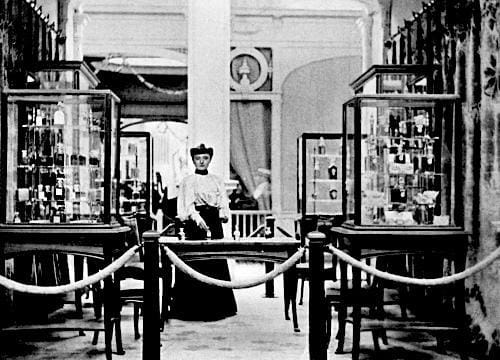
Above: 1905 Houbigant display at the Exposition Universelle et Internationale de Liège.
After taking over the business, Javal et Parquet decided to focus Houbigant-Chardin firmly on perfumes. They shut down the glove-making side of the business in 1881 and liquidated all their remaining stocks of gloves. They may have also deleted other items from the Houbigant-Chardin inventory but I have no information about this.

Above: 1881 Houbigant announcement that they were selling off their gloves at incredibly cheap prices and would now devote themselves to the development of perfumes and the famous Eau d’Houbigant.
To accomplish their aims, Javal et Parquet built new manufacturing facilities in the factory at 141 Avenue du Roule, Neuilly-sur-Seine which had first opened in 1880. These were further expanded and/or modernised as new manufacturing procedures were developed and demand increased in the twentieth century. Part of the building was demolished and rebuilt in 1908, perhaps the result of moving from steam-power to electricity.
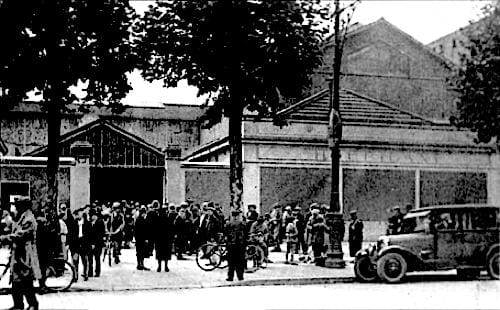
Above: Houbigant factory at 141 Avenue du Roule, Neuilly-sur-Seine.

Above: Workers outside the factory at Neuilly-sur-Seine.
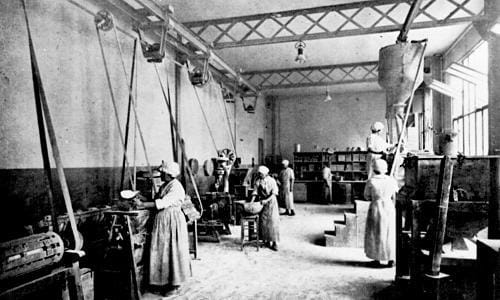
Above: Making face powder at Neuilly-sur-Seine.
As previously mentioned, Javal et Parquet also closed down the Houbigant-Chardin shop in Regent Street. At some stage they also dropped Chardin from the company title which then became Parfumerie Houbigant or just Houbigant.
Products
A major advance in the development of perfumes came with the replacement of expensive natural ingredients with cheaper synthetics. Houbigant led the way with Fougère Royale, developed by Paul Parquet in 1882. It is generally regarded as the first perfume to use a synthetic compound – coumarin – which was first synthesised by William Henry Perkin [1838-1907] in 1868. Fougère Royale was initially used in a toilet soap and only later appearing in other products and as a perfume (Billot, 1966). It would also be used to fragrance Houbigant’s range of mens’s toiletries.
Naming a fragrance Fougère Royale (Royal Fern) seems a little odd as ferns do not have a particular smell. Some perfume historians suggest that it was named after Osmunda regalis, a species of fern known by the French as Fougère Royale and that the name was chosen because of the late nineteenth-century craze for collecting and growing ferns.
Between 1880 and 1920 Paul Parquet and Robert Bienaimé created a number of other fragrances for Houbigant. Those listed as significant by Billot (Billot, 1966) were Le Parfum Ideal (n.d.), Coeur de Jeanette (1900), L’Oeillet du Roy (1907), La Rose France (1907), and Quelques Fleurs (1912). The dates for the introduction of these perfumes are his.
Houbigant used these fragrances in all the usual ancillaries including sachets, toilet waters, toilet powders, talcum powders, toilet soaps, shaving soaps, bath salts, brilliantines, face powders, and rouges.
United States
Houbigant lost its Russian market during the First World War when the Russian Revolution toppled the Tsarist regime. Its other European markets had also been badly affected by the war making the North American market, particularly the United States, look increasingly attractive. A number of other French perfumery companies had the same idea. For example, Coty formed Coty, Inc. in New York in 1922.
See also: Coty
Houbigant-Chardin fragrances had been imported into the United States from the 1850s at least, with Park & Tilford acting as Houbigant’s American distributor in 1920. In that year, Houbigant terminated its agreement with Park & Tilford and founded Houbigant, Inc. New York which moved into offices at 16 West 49th Street, New York in 1921.
Yvan Droz (James Adolphe Yvan Amez-Droz) came over from France to become the president of Houbigant, Inc. and Charles S. Welch was made the new company’s vice-president and general manager. Welch had been at Park & Tilford since 1910 and was the manager of their perfume department before he moved to Houbigant.
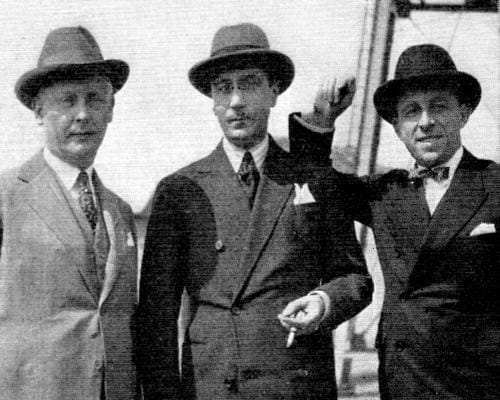
Above: 1925 Robert Bienaimé [1876-1960], Yvan Droz [1888-1976], and Fernand Javal [1884-1977] arriving in New York.
Paul Schving (Paul Florent Henri Schving) [1889-1929], a chemical engineer and director of the Houbigant factory in Neuilly-sur-Seine, was also dispatched from France to help organise the business in New York.
Houbigant, Inc. moved into a new purpose-built 11-story building at 539 West 45th Street, New York in 1924 and sales offices were opened in Chicago (1924) and San Fransisco (1926). The increased demand in the American market saw Houbigant also expand its facilities in New York when it added an adjoining 12-story building at 549-553 West 45th Street in 1928.
I do not know how much manufacturing went on at the building in West 45th Street as I have no interior photos or descriptions of its facilities. Houbigant claimed that its perfumes were fully imported but it seems likely that these came into the country as concentrates before being mixed with American alcohol in New York. This would certainly have helped Houbigant reduce the duties levied on the material it imported under the Tariff Act of 1922. Cosmetics and packaging could all have been made in the United States.
Canada
In Canada, Houbigant also terminated Park & Tilford’s distribution rights there in 1921, and establishing a Canadian company, Houbigant Limitée (capital CA$49,000), at 46 Rue Saint-Alexandre, Montreal later in the year. The company moved to larger premises in the Unity Building at 46 St. Alexander Street, Montreal in 1922.
France
Needing more capital, Javal and Bienaimé founded the Société Anonyme des Parfumerie Houbigant (capital ₣22 million) in France in 1922. At some stage during the 1920s, they also took over the adjacent building at 17 Rue du Faubourg Saint-Honoré thereby extending their shop front through to the Rue Boissy d’Anglais.
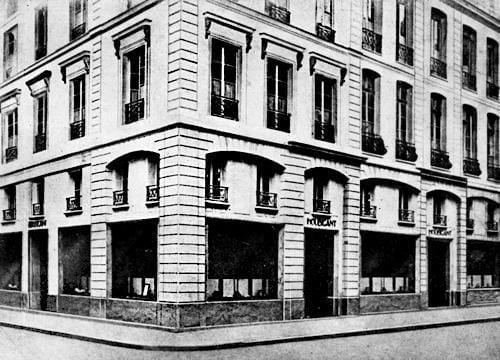
Above: 1927 Houbigant at 17-19 Rue du Faubourg Saint-Honoré on the corner of Rue Boissy d’Anglais.
I do not have any information of any upgrades to the factory at Neuilly-sur-Seine in the interwar period but it seems likely that these would have been significant.
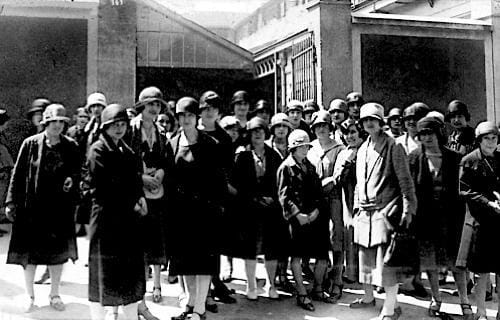
Above: Workers outside the factory at Neuilly-sur-Seine in the 1920s.
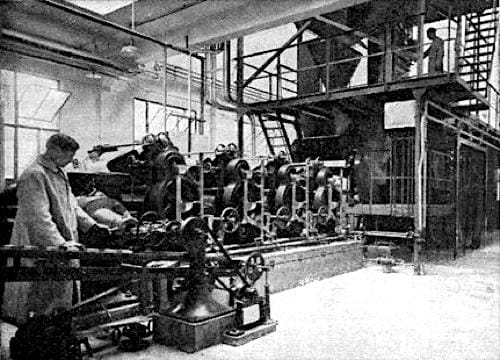
Above: Manufacturing soap in the factory at Neuilly-sur-Seine.
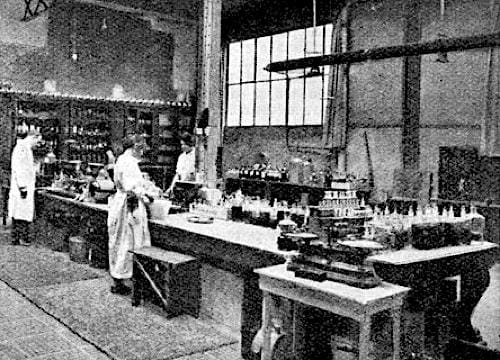
Above: Manufacturing perfumes in the factory at Neuilly-sur-Seine.
Cheramy
Some of the growth in Houbigant’s business during the 1920s was due to the creation of a new subsidiary – Parfums Cheramy. This first appeared In 1921 with the establishment of Cheramy, Inc., at 102 West 72nd Street, New York with Robert Bienaimé as its major shareholder. The brand was then expanded to France and other markets where Houbigant was already available. It had a lower price point than Houbigant and was probably developed as a cheaper line for younger women.
See also: Cheramy
Products
By 1920, Houbigant was selling a wide variety of fragrances that were also used to scent a wide variety of cosmetics and toiletries. Ancillaries introduced with a new perfume usually included a face powder with other items created depending on the popularity of the perfume. For example, Quelques Fleurs, Houbigant’s best known and most popular fragrance, also came as a loose and compressed face powder, talcum powder, bath salt, sachet, toilet water, brilliantine, and soap.

Above: Houbigant showroom, date and place unknown.
Skin-care
Information on Houbigant’s skin-care cosmetics in the 1920s is very fragmentary but it was selling at least three beauty creams in the United States in 1920 – Quelques Fleurs Skin Lotion, Houbigant Cold Cream, and Crème En Beauté. Houbigant had been making Cold Cream back in the nineteenth century so it is the oldest of the three.
Crème En Beauté, which dates from the early 1920s, was a vanishing cream formulation primarily recommended as a powder base. Most were sold scented with Quelques Fleurs but there was also a version perfumed with Parfum Spécial which was said to harmonise with other make-up fragrances. Crème En Beauté was sold in a ceramic pot but Houbigant also produced a version in a tube that could be carried in a purse or handbag.
See also: Cold Creams and Vanishing Creams
Quelques Fleurs Skin Lotion was suggested as a day lotion and skin protectant but I know nothing regarding its formulation.
After the Le Temps des Lilas perfume was introduced in 1922 Houbigant added a fourth skin cream, Le Temps des Lilas Cream which could be used as a cleanser or as a night cream. I have been unable to find evidence for this cream in Britain or France so it is possible that it was developed for the American market.
Houbigant Cold Cream: “[F]ragrant and pure, to rest the tissues before sleep.”
Crème En Beauté: “[T]he ideal basis for powder, the foe to a shiny nose and makeup that shows on the edges.”
Quelques Fleurs Skin Lotion: “[H]oney-sweet and creamy-smooth—the wise woman’s protection against sun and wind and dust, giving and keeping a velvet skin.”
Le Temps des Lilas Cream: “[F]resh and sweet as new-cut lilacs—the ideal cleansing and night cream to purify and smooth the skin.”
Make-up
Houbigant continued to retail loose (Poudre de Riz) and compressed (Poudre Comprimée) face powders in a wide variety of fragrances. Both types of face powder were made using the same formulation and came in the same shades.
There appears to have been some variation in the powder shade ranges available in Europe, Britain and the United States but, by the end of the decade Houbigant was producing face powders in Blanche, Rosée, Rachel, Naturelle, Ocre, Ocre Rosée, and Rachel Soleil shades; lipsticks in Orange, Carmin, and Grenat; and rouge in Blonde, Brune, Orange, Carnation, Mat, and Doré.
Houbigant combined its lipsticks, face powders and rouges into a wide variety of single, double and triple compacts. Until the 1930s, most of these had a metal finish or had a version with a basket of flowers image on their lid. One of the most common compacts of the period was a small gilt metal compact introduced in 1927.
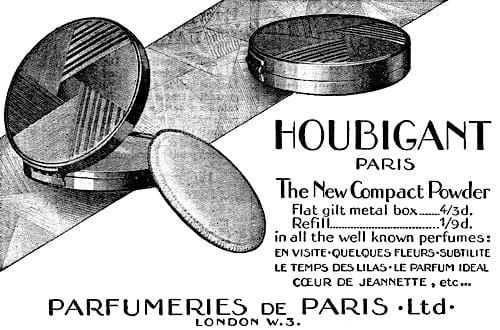
Above: 1927 Houbigant Powder Compact (UK). Houbigant used this design to package its compact powders and rouges with both compacts coming in small, medium, and large sizes. The powder compact made with this design came in Naturelle, Ocre, Rachel, Ocre Rosée, Blanche, and Rosée shades in ten of Houbigant’s more popular fragrances. The rouge compact was available in Blonde, Carmin, Mat, Brune, Orange and Doré shades. When you take size, perfume and shade into consideration you are left with a bewildering number of possible combinations.
Some Houbigant compacts made during this time were hexagonal in shape perhaps because France was often referred to as ‘Le Hexagone’ due to the shape of the country.
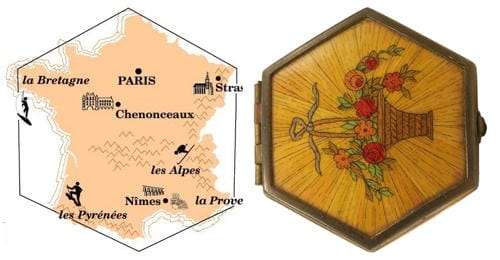
Above: Houbigant hexagonal-shaped compact.
Hands and Nails
Crème Houbigant à la Vaseline, used to soften the hands, was in the Houbigant inventory in the 1880s but I do not know if it was still made and sold in the twentieth century. In 1926, Houbigant inc. began selling Quelques Fleurs Hand Lotion, It was probably formulated along the lines of Quelques Fleurs Skin Lotion as Houbigant seemed to combine these two products in the 1930s.
Quelques Fleurs Skin and Hand Lotion: “[A] liquid cream that touches your skin with instant glamour. It’s so very lovely that you might almost forget the practical things it does for face, hands, arms and shoulders. Smoothing, whitening, it corrects redness and roughness, prevents chapping, leaves your skin velvety soft and enchantingly fragrant, without stickiness.
Houbigant did make a number of nail cosmetics all badged as Ruba from as early as the 1910s through to at least the 1930s. Three of these – Pâte Ruba (paste), Poudre Ruba (powder), and Pierre Ruba (stick) – contained polishing powders and were combined with a buffer to polish the nail.
See also: Nail Powder Polishes
Crayon Ruba also required buffing but did not contain an abrasive as the shine was produced by the application of a thin layer of wax. As the name suggests, it was sold as a coloured wax stick which looked a little like a lipstick. I have not come across many of these wax nail sticks and the only other one that I know of was also French.
Émail Ruba was a liquid nail polish packaged in glass bottle. that was applied with a brush attached to the lid. It came in at least two shades, a clear polish and one that was slightly tinted with a dye to give the nail a pink hue.
See also: Nail Polishes/Enamels
Beauty routines
As might be expected, given Houbigant’s limited cosmetic range, Houbigant beauty routines were simplistic and tended to concentrate on the importance of fragrance.
Houbigant’s Creme En Beauté is the ideal cream base for make-up, a vanishing cream with no wax in it, indescribably soothing to the skin—softly, freshly odorous. Over this comes the Houbigant Rouge in your own shade, applied lightly. Not concentrated in spots—that’s old fashioned—but rubbed in to give a soft diffused glow to the face. Over it again, your own special shade and fragrance in Houbigant Powder, dusted on delicately. Then a firm, lovely, faintly-perfumed Cupid’s bow with your Houbigant Lipstick. And not the least subtle part of the charm is the elusive suggestion of perfume that breathes from every bit of your make-up to reinforce your favorite of the Houbigant Five Odors!
(Houbigant, 1925, p. 17)
See also: Things Perfumes Whisper (1925)
Men’s range
Houbigant developed a men’s toiletry range based aroung the Fougère Royale fragrance which was helpfully named after a fern rather than a more feminine flower. The series included all the usual men’s toiletries including a Shave Stick, Shaving Cream, After Shave Lotion, Facial Soap, and Talcum Powder.
End of the decade
As the 1920s drew to a close, Houbigant must have been very optimistic about its future prospects. Its products were being sold around the world and business in the important American market appear to be progressing well. However, the stock market crash of 1929 and subsequent depression would force the company to reevaluate its position.
Timeline
| 1775 | Houbigant opens a perfume shop in Paris. |
| 1808 | Nicole Houbigant, marries François Magny and the business becomes Houbigant-Magny. |
| 1815 | Houbigant bought by Félix Chardin which then becomes Houbigant-Chardin. |
| 1837 | Houbigant-Chardin opens a shop at 216 Regent Street, London. |
| 1854 | Gabillot et Compagnie acquires Houbigant-Chardin. |
| 1862 | Gilbert et Dormage purchases Houbigant-Chardin. |
| 1880 | Factory opened in Neuilly-sur-Seine. |
| 1881 | Javal et Parquet establish a partnership to control Houbigant-Chardin. |
| 1918 | Javal et Bienaimé founded in Paris. |
| 1920 | Houbigant Inc. founded in New York. |
| 1921 | Houbigant Limitée founded in Montreal. Cheramy, Inc. established in New York. |
| 1922 | Parfumerie Houbigant S.A. founded in Paris. Houbigant Limitée moves to 46 St. Alexander Street, Montreal. |
| 1924 | Houbigant Company Building, built at 539 West 45th Street, New York. Houbigant, Inc. opens a branch office in Chicago. |
| 1925 | Parfumeries de Paris appointed British agents for Houbigant. |
| 1926 | Houbigant, Inc. opens a branch office in San Fransisco. New Products: Quelques Fleurs Hand Lotion. |
| 1927 | New Products: Rouge Beauté. |
Continue onto: Houbigant (post-1930)
First Posted: 11th August 2024
Last Update: 26th August 2024
Sources
The American Perfumer & Essential Oil Review. (1906-1955). New York: Robbins Perfumer Co. [etc.].
Bertrand, C. F. (1809). Le parfumeur impérial. Paris: Brunot-Labbe.
Billot, M. (1966). 75 years of perfume creations. American Perfumer and Cosmetics, 81(April), 51-56.
The Drug and Cosmetic Industry. (1932-1997). New York: Harcourt Brace Jovanovich [etc.].
Houbigant, Inc. (1925). Things perfumes whisper [Booklet]. USA: Author.
La parfumerie française et l’art dans la présentation. (1925). Paris: La Revue des Marques de la Parfumerie et de la Savonnerie.
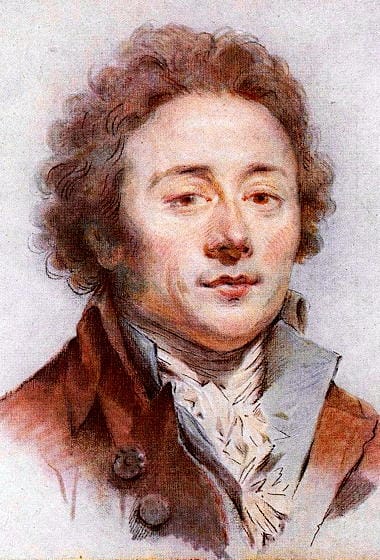
Jean-François Houbigant [1752-1807] painted by Claude Jean Baptiste Hoin [1750-1817].

Mid-nineteenth-century Houbigant counter card.
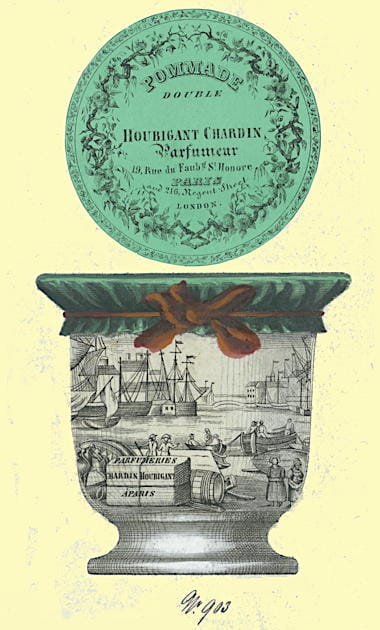
c.1860 Houbigant-Chardin Pommade (Vienna).
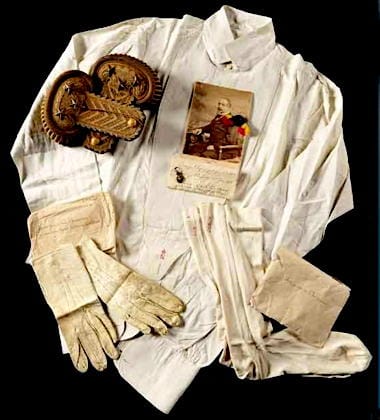
Objects once owned by Napoleon III (Charles-Louis Napoléon Bonaparte) [1808-1873] including a pair of Houbigant-Chardin gloves.
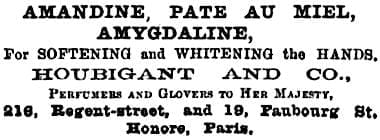
1873 Houbigant and Co. (Britain).
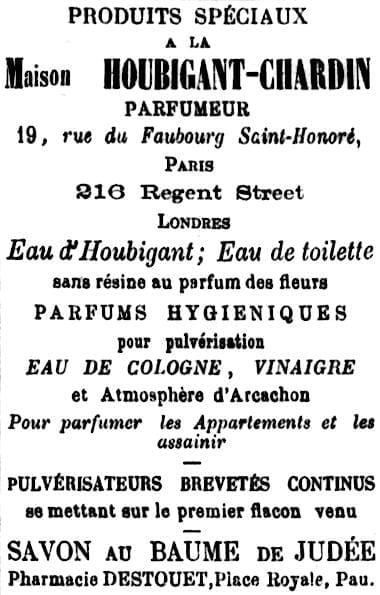
1875 Pharmacie Destoutet, Place Royal, Pau selling Houbigant-Chardin products.
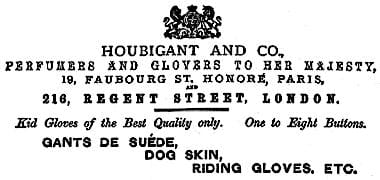
1876 Houbigant and Co. perfumers and glovers, London. I have no records that this company was established in Britain.
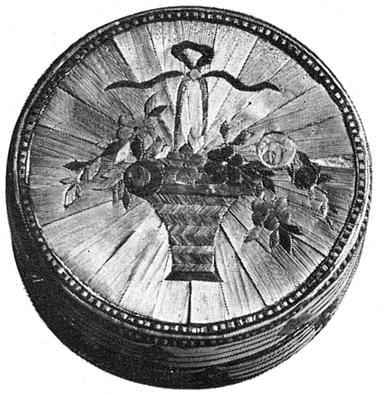
Eighteenth-century Houbigant-Chardin powder box that served as the model for Houbigant powder boxes that were introduced in 1922. It was part of a vintage collection begun by Fernand Javal in 1919.
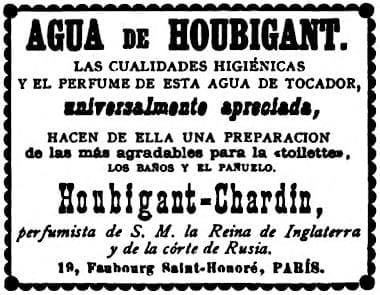
1883 Agua de Houbigant (Madrid).
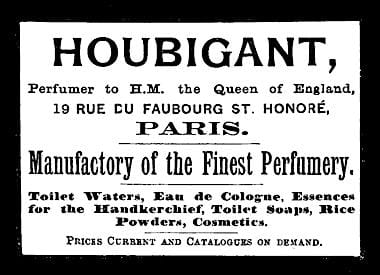
1885 Trade advertisment for Houbigant (UK).
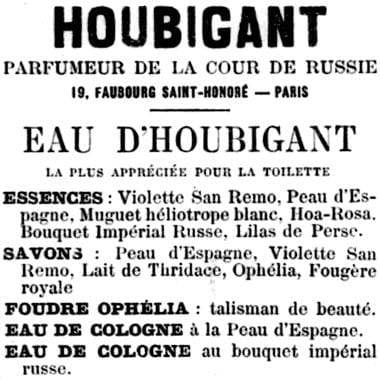
1891 Houbigant.
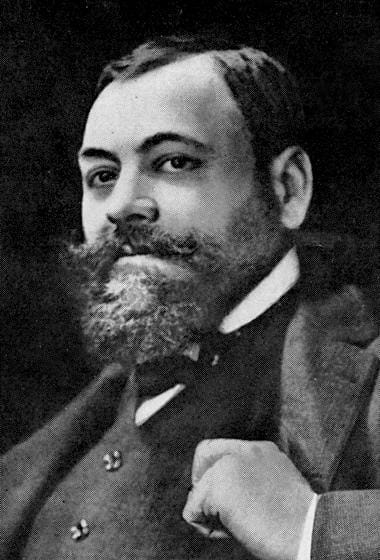
Paul-Marie Parquet [1865-1916].
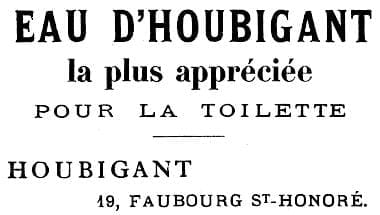
1896 Eau d’Houbigant.
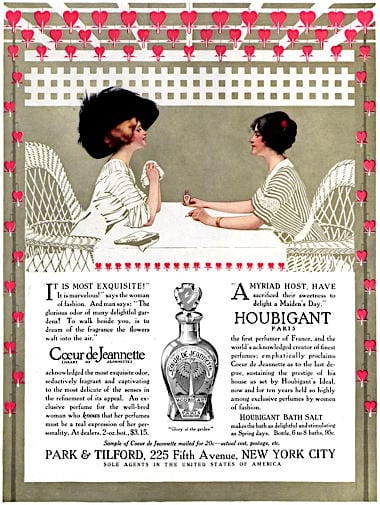
1912 Houbigant Coeur de Jeannette (USA).

1913 Houbigant Quelques Fleurs (USA).
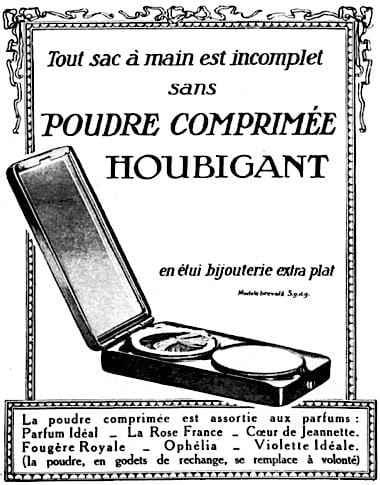
1914 Houbigant Poudre Comprimée in Idéal, La Rose France, Coeur de Jeannette, Fougère Royal, Ophélia, and Violette Idéale fragrances (Austria).
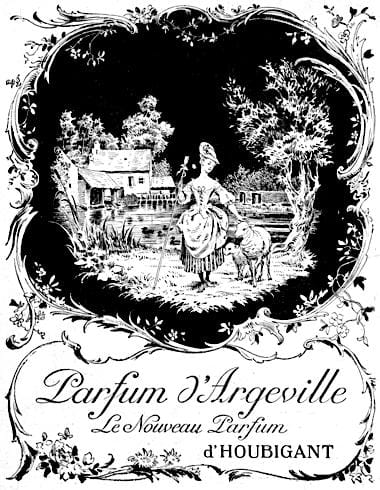
1914 Houbigant Parfum d’Argeville one of the lesser known perfumes produced by Houbigant.
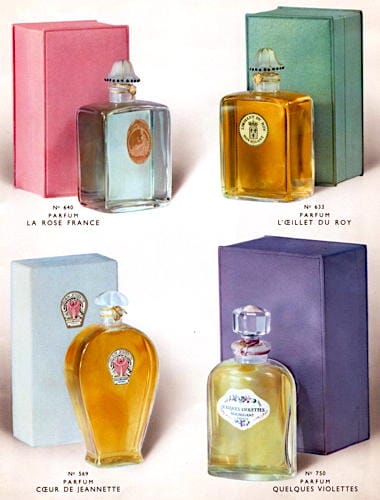
Houbigant La Rose France, L’Oeillet du Roy, Coeur de Jeanette, and Quelques Violettes.

1915 Houbigant Talcum in Coeur de Jeanette, Ideal, and Quelques Fleurs fragrances (USA).
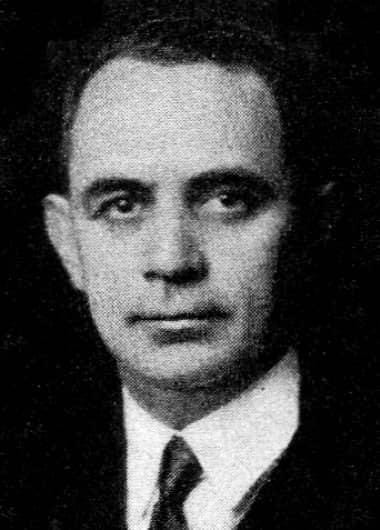
Charles Sylvester Welch [1882-1942], the first general manager of Houbigant, Inc.

Houbigant at 16 West 49th Street, New York.
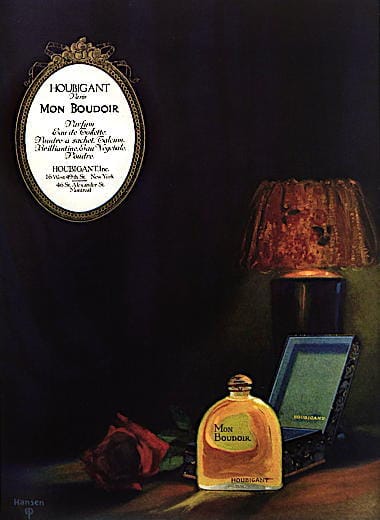
1921 Mon Boudoir (USA).
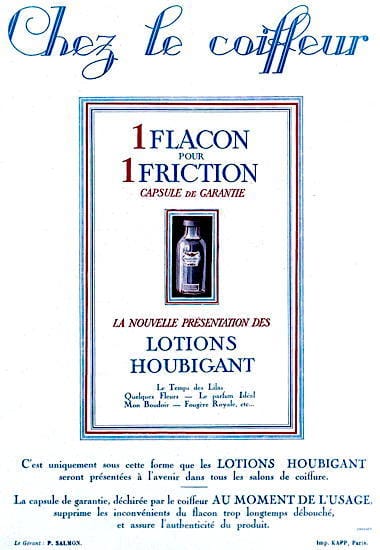
1922 Lotions Houbigant for the hair.
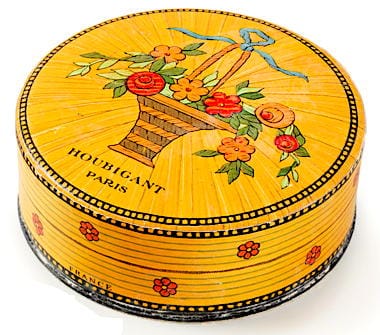
Houbigant Quelques Fleurs Powder Box. Powder boxes like this date from 1922.
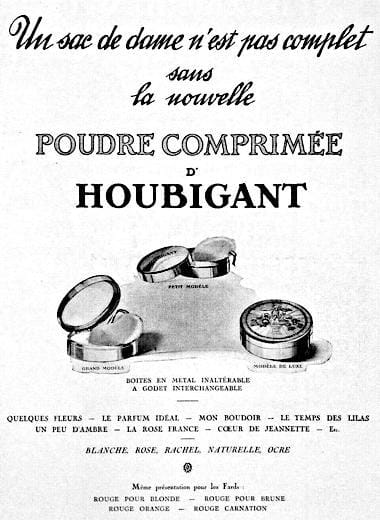
1923 Houbigant Poudre Comprimée.
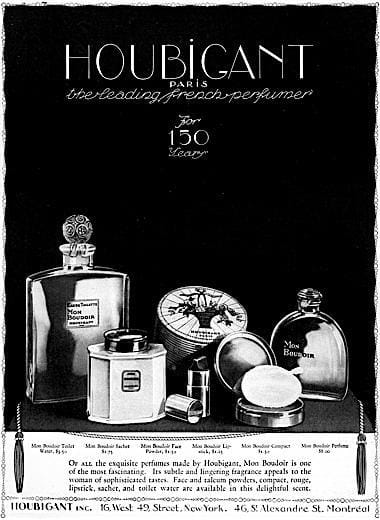
1924 Houbigant Mon Boudoir (USA).
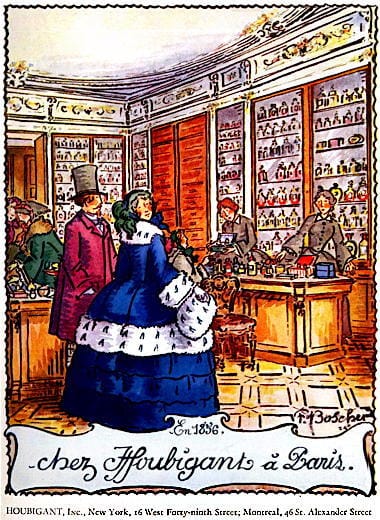
1924 Houbigant (USA).
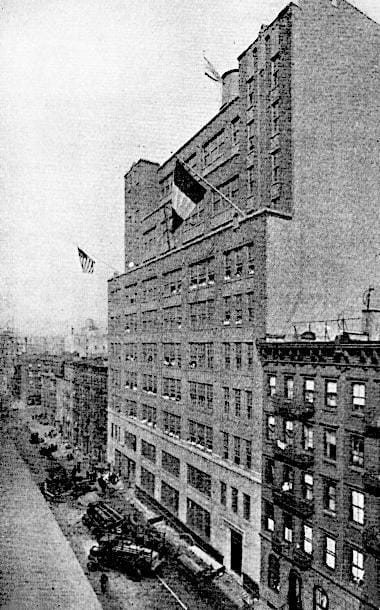
1925 Houbigant Company Building at 539 West 45th Street, built by Lockwood Greene & Company.
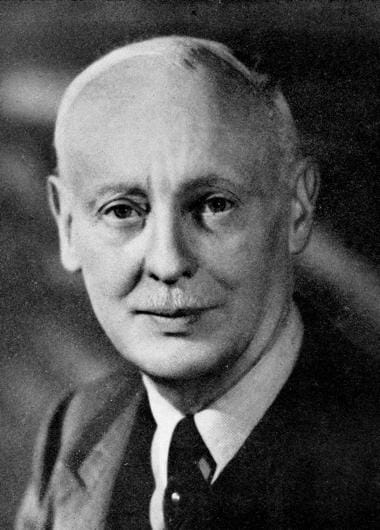
Robert Henri Bienaimé [1876-1960].
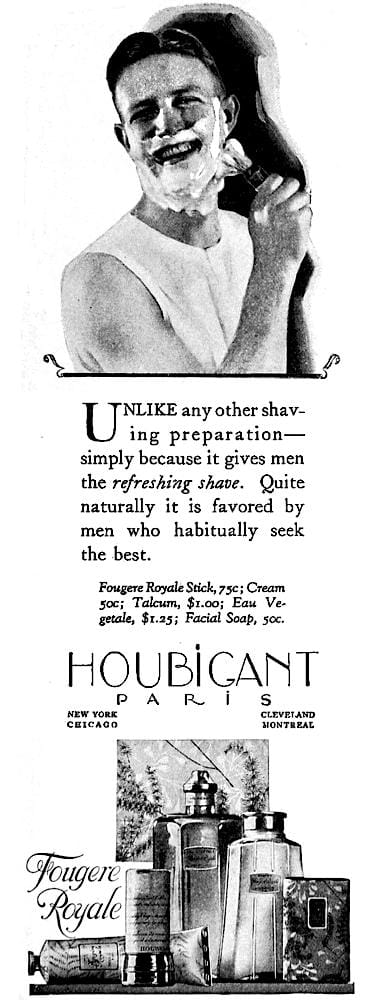
1926 Houbigant Fougere Royale Stick, Cream, Talcum, Eau Vegetale, and Facial soap.
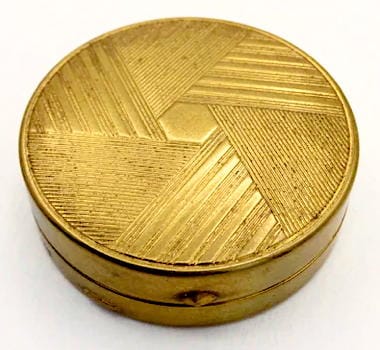
Houbigant compact Introduced in 1927.
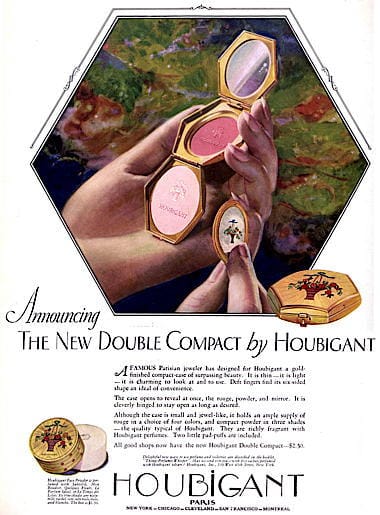
1927 Houbigant Double Compact (USA). The hexagon shape may have been chosen as France was often referred to as ‘Le Hexagon’ by the French.
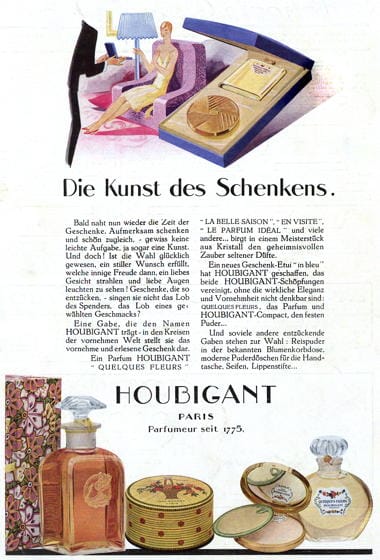
1927 Houbigant (Austria).
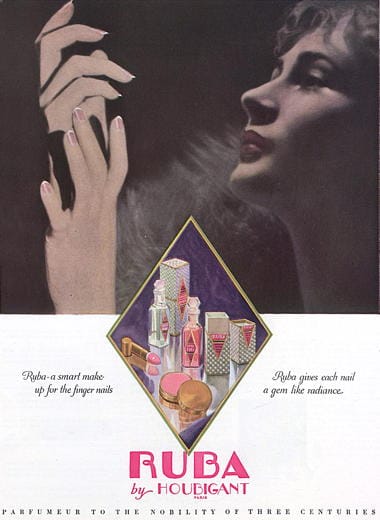
1928 Houbigant Ruba Nail Polish (USA).

1928 Houbigant Bath products (Austria).
